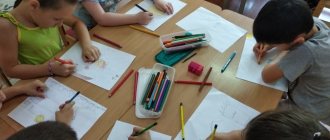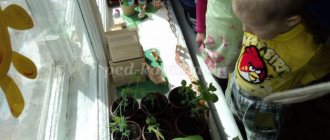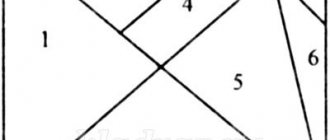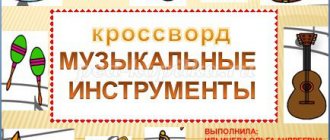Project in the senior group of kindergarten on the topic “The Magic World of Theater”
Organization of project activities for children in the senior group on the topic: “The Magic World of Theater”
Author of the project : Elena Vladimirovna Ivanova, teacher of the 1st qualification category of MBDOU “Kindergarten No. 34”, Ivanovo
Project type: creative and educational; Duration of the project: long-term (January-May) Project participants: children of the senior group, their parents, teachers, artists and employees of the Ivanovo Drama Theater. Relevance of the project: After watching a fairy tale in kindergarten, shown by artists of the Ivanovo Drama Theater, it turned out that many of the children had never been to the theater. They have no idea what it is, who works there, what it is needed for. Those children who were in the theater with their parents spoke with delight about the fairy tale they watched, but could not tell anything about the theater itself. The preschool children expressed a desire to learn more about him. This is how the idea of creating the “Magic World of Theater” project arose. Problem: Children have not developed an interest in the world of theater. Reasons: 1. Children and their families do not attend the theater or do so rarely. 2. Not enough time is spent in the family talking about the theater. 3. Lack of understanding by parents of the importance of theatrical activities for the development of the child. 4. Interest in theater is replaced by watching TV and playing computer games. Project goal: To develop an interest in theater and modern theatrical activities in children and their parents, and to develop artistic abilities in children. Objectives of the priority educational area: “Cognitive development”:
• To form children’s ideas about the theater, its types, about the people who work in the theater, about artists;
• Show the importance and necessity of each profession in the theater; • Expand children's horizons. • Develop children's interests, curiosity and cognitive motivation; Objectives of the OO in integration: “Artistic and aesthetic development”:
• Arouse interest in theater in children and parents;
• Instill in children primary skills in the field of theatrical art (use of facial expressions, gestures, voice); • Promote the development of children's creative activity. • Stimulate the development of creative, search activity, and independence of children; • Involve children and parents in joint design activities in modeling costume elements, scenery, and attributes. “Social and communicative development”:
• To arouse in children an interest in theater, a desire to participate in theatrical activities;
• To interest parents in visiting the theater with their children; • Reinforce the rules of behavior during a tour of the theater and when attending performances; • Reinforce the rules of safe behavior on the way to the theater; • Form positive relationships between children in the process of joint activities; “Speech development”:
• Activate and improve vocabulary, grammatical structure of speech, sound pronunciation, coherent speech skills, melodic-intonation side of speech, tempo, expressiveness of speech.
• Foster a culture of verbal communication, self-respect, and a conscious attitude towards one’s activities; “Physical development”:
• promote an increase in physical activity aimed at developing coordination of movements, developing gross and fine motor skills;
Expected results: 1. Children's interest in theatrical culture will expand. 2. Children’s knowledge about the history of the theater, its types, and the professions of people working in the theater will be enriched. 3. Children's creative abilities will be revealed. 4. Children's horizons will broaden and their vocabulary will be enriched. 5. Parents will become interested in visiting the theater with their children. Project products: • Creation of a subject-based environment that promotes the development of theatrical culture in children; • Theatrical performance based on the Russian folk tale “Kolobok”. Prerequisites for educational activities: personal
- the ability to evaluate one’s own activities and one’s capabilities;
communicative
- the ability to listen and answer questions, ask for help, express gratitude;
participate in joint activities; cognitive
– the ability to work according to a given algorithm;
regulatory
– the ability to carry out actions according to a model and a given rule;
the ability to listen to an adult and follow his instructions; Equipment for the teacher: laptop, camera, video camera, stereo, TV, DVD, video and audio materials, Internet. Equipment for children: different types of tabletop theaters, materials for productive activities (art activities, appliqués, modeling), themed sets and toys for role-playing games, masks, costumes, attributes for theatrical performance.
Forms and methods of project organization - Pedagogical observations. - Conversations. — Consultations for parents (individual and group). — Joint organized activities. — Registration of information for parents in the reception area. — Creative workshops (with children, with parents, individual, group). - Master classes for parents on making attributes, costumes - Theatrical activities (productions, skits) - Games - Reading fiction - Listening to audio tales - Excursion to the Ivanovo Drama Theater; — Watching outdoor performances at preschool educational institutions, performances at the Ivanovo Drama Theater.
Interaction with the families of students: 1. Help in replenishing the theater corner in the group; 2. Trips to the theater for performances with children; 3. Organization of excursions into the world of the backstage of the Ivanovo Drama Theater; 4. Joint work on the production of attributes and costumes for the theatricalization of the fairy tale “Kolobok”; 5. Advisory and educational work;
Main stages of the project: 1. Preparatory stage: Goal setting: Objectives: 1. Determine the purpose and objectives of the project, generate interest among parents in creating conditions for its implementation. 2. Study and create an information base for the project. 3. Draw up a project plan, distribute responsibilities between project participants, and arouse children’s interest in the project topic. 4. Organize parents to help carry out this project, involve them in the process of solving the assigned tasks. 2. Main stage: • Organization of work on the project: Objectives: 1. Create a developmental environment on this topic (Stimulate the development of creative, search activity, independence of children) 2. Select and make costumes, attributes for the production of a fairy tale (Create conditions for the formation of interest in theatrical art). 3. Selection of information, literature, additional material (Develop a sustainable interest in theatrical and play activities). 4. Organize a tour of the Ivanovo Drama Theater (invite parents to cooperate).
• Implementation of the project in different types of activities, taking into account the integration of educational areas: Objectives: 1. Use dramatization games during educational activities for speech development and music classes; 2. Use dramatization games when reading fiction; 3. Develop coherent speech through theatrical activities. 4. During organized labor activities, make attributes for theatrical productions. Viewing presentations
on the history of theater and theatrical costume “How the theater arose”, “History of theatrical costume” (Continue to develop a sustainable interest in theatrical and play activities)
Making attributes
, costumes, masks for theatrical activities based on the Russian folk tale “Kolobok” (Introducing children and parents to joint design activities on modeling costume elements, scenery, attributes.)
Acting out fairy tales
using various types of theater (To consolidate children’s understanding of various types of puppet theater, be able to distinguish them and name them)
Role-playing games
with children “Theater”, “ Family”, “Artists are preparing for the performance” (Expand children’s ideas about the surrounding reality)
Conversations:
“What should an actor be like?”, “Who helps actors?”, “How to behave in the theater” (Expand children’s ideas about the surrounding reality. Review the rules of behavior in the theater)
Conversation
“What are theatrical props for?”
“What is scenery?” (Planning children’s activities to create scenery, attributes for fairy tales and the role-playing game “Theater”) Conversations
with theater actors about the profession, master classes for children
Production of props
, posters, tickets for role-playing games and for the showing of the fairy tale “Kolobok” (Organization of joint activities in the form of a creative workshop)
Games based on the plots of
fairy tales and poems.
Dramatization of fairy tales (encourage the manifestation of independence and creativity in solving game situations; cultivate friendly relations between children) Dramatization games
(Form in children an emotional and imaginative perception of works through artistic description of images, develop imagination; develop emotional expressiveness of speech)
Games for the expression of emotions
, on the development of facial expressions (develop facial movements, the ability to show an emotional state through facial expressions, gestures)
Listening to audio fairy tales
performed by honored artists (Develop the ability to listen carefully to fairy tales, catch the various intonations of actors’ voices, recognize the heroes of fairy tales by ear)
Creative workshop
for making crafts based on fairy tales, drawings , applications
Excursion
to the prop room of the Ivanovo Drama Theater (Introduce children to the backstage of the theater, the professions of people working in the theater; familiarize them with the rules of behavior in public places)
Trips to the
Ivanovo Drama Theater for performances (creating interest in theatrical art)
3. Final stage: Presentation of the project Objectives: 1. Prepare for the show a theatrical performance based on the Russian folk tale “Kolobok” (Support children’s desire to actively participate in holidays and entertainment, using the skills acquired in joint and independent activities.). 2. Photo report about the theater tour, made in the form of a wall newspaper (an opportunity to share impressions and talk about what you saw). Project results: As a result of work on the project “The Magical World of Theatre”:
1. Children have developed an interest in the world of theater, theatrical and play activities. 2. Children actively and willingly participate in theatrical performances: they perform in front of parents, theater artists, and children from other groups. 3. The subject-developmental environment in the group has been updated (the theater corner has been replenished with costumes, masks, attributes, the puppet and table theaters have been updated) 4. Parents take an active part in the life of the preschool educational institution: they organize trips to the theater for performances, excursions, and participate in preparation for theatrical performances .
We recommend watching:
A project in a kindergarten for older preschoolers aged 5-7 on legal topics. A script for theatrical entertainment based on fairy tales together with parents in the younger group. A project in the older group. Theater and children DIY theater on a magnetic board for kindergarten
Similar articles:
Sketch - dramatization for children 5-6 years old
Re-enactment of the fairy tale “Turnip” for children
Sketch “Mom and Daughter” based on roles for kindergarten
Project for children of the senior group “Our cheerful garden”
MAGAZINE Preschooler.RF
Project on theatrical activities for the senior group of kindergartenCity of Kazan Republic of Tatarstan
Goal: To develop an interest in theater and modern theatrical activities in children and their parents, to develop artistic abilities in children.
Tasks:
- Arouse interest in theater in children;
- To instill in children primary skills in the field of theatrical art (the use of facial expressions, gestures, voice, puppeteering);
- To interest parents in visiting the theater with their children;
- Provide information to parents about ways to play games at home with their children;
- Develop emotionality and expressiveness of speech in preschoolers
A problem that is significant for children, which the project aims to solve:
Unfortunately, today, our children are brought up not on fairy tales, but on modern cartoons. Most parents don't have time to sit down with their child and read a book. Child psychologists consider this a big omission of adults in raising their children.
Expected Result:
Parents and children get acquainted with the history of the theater, its types, methods of production and performance. The desire to visit the theater with children increases. Bonds between parents and educators are strengthened. Children's artistic abilities develop.
Relevance of the project:
With the help of theatrical activities, children get acquainted with the world around them in all its diversity through images, colors, sounds, and the questions posed make children think, analyze, draw conclusions and generalizations. In the process of playing, listening, viewing works, the child’s vocabulary is activated, the sound culture of speech and its intonation structure are improved, the child’s creativity is manifested, and the experience of various experiences is accumulated. Children's artistic abilities develop from performance to performance. Theatrical activities contribute to the harmonious development of preschool children. Their life in kindergarten becomes more interesting, more meaningful, filled with vivid impressions and the joy of creativity.
Forms of implementation:
- Reading fiction
- Speech and breathing exercises
- Entertainment
- Conversations
- Viewings of theatrical works for children, presentations
- Working with parents
- Role-playing games
- Photo design - newspapers
- Going to the theater
Implementation stages:
Preparatory stage
- Collection of literature
- Conversations with children
- Drawing up a work plan
- Making attributes
- Development of recommendations for parents
- Selection of visual information
Main stage
- Watching children's performances
- Stand design recommendations for parents:
"Theater in a child's life";
"Play with your children";
“The role of fiction in the development of children’s speech”
- Role-playing games with children “Theater”
- Finger Theater
- Expression games “Make a face”
- Reading folk tales
- Games for developing facial expressions
- Theater “Kem narsә yarata” , “Three Daughters”
- View slides about theaters and theatrical costumes
- Rehearsals
- Learning poems
- Photo design for the newspaper “We are Artists”
- Breathing exercises
- Articulation gymnastics
- Finger gymnastics
- Fine motor skills exercises
- Poetry dramatization
Project products for children:
Modeling, drawing and appliqué of a “Hero from a favorite fairy tale, drawing characters from the fairy tale “Kem Nerse Yarata” , new knowledge and impressions, meaningful time spent with parents, children's books.
for teachers:
design of a thematic album “Heroes of our favorite fairy tales” , card index of proverbs, sayings, riddles, multimedia presentations, finger theater, organization of an exhibition of children's works.
for parents:
a meaningful day off with the child, new impressions and level of pedagogical competence, joint activity in making drawings. Participation in an exhibition of children's works. Making attributes.
Final stage (project presentation)
- Photo – “We Are Artists”
- Theatrical activities of children as part of the holiday
- Showing the fairy tale “Three Daughters” by parents to children
| Next > |





